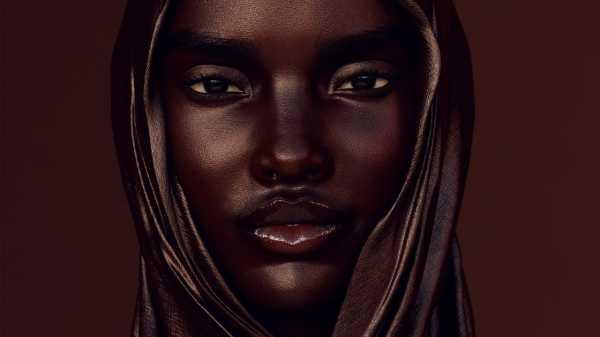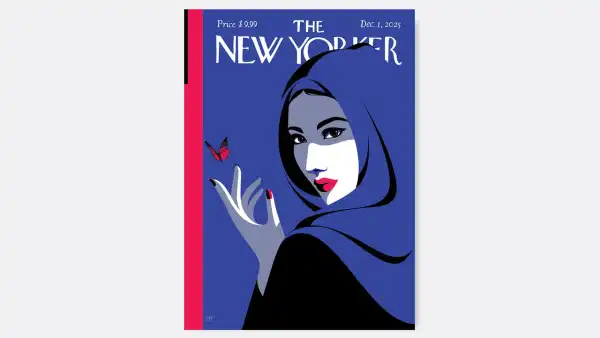
A year ago, photographs of a model named Shudu Gram began appearing on Instagram. She had luminous dark-brown skin and perfectly symmetrical features, and, in a series of photos, wore iindzila, the neck rings associated with the Ndebele people of South Africa. Soon, her otherworldly beauty attracted a following, with her photos shared on pages celebrating women of color, accompanied by laudatory hashtags such as #blackisbeautiful, #melanin, and #blackgirlsrock. In one pair of photos, posted in August, Shudu wore a vibrant yellow T-shirt from the apparel brand Soul Sky. “I can’t describe how grateful I am to @soulskybrand for sending me this beautiful t-shirt,” the caption to one of the photos read, and tagged the company’s designer, Semhal Nasreddin, who then reposted the image on her brand page. Most viewers on Instagram expressed awe at Shudu’s beauty, although there were some voices of dissent. “I feel like you should tell me when the ‘people’ modeling your clothes aren’t actually people,” one commenter wrote.
That commenter knew something that many of Shudu Gram’s thousands of followers hadn’t realized: that she was not a human model but a computer-generated character. Gram was not the first C.G.I. model to become an “influencer”: the freckled young Brazilian-American Miquela Sousa, or Lil Miquela, has modelled merchandise and promoted social causes on social media since 2016; she now has a million-plus Instagram followers, and her song “Not Mine” has nearly 1.5 million plays on Spotify. (It was recently revealed that Lil Miquela was created by the Los Angeles-based startup Brud, which also staged the hacking of her Instagram account as a P.R. stunt.) Shudu Gram has courted a different kind of controversy, one originating from the fact that, as Harper’s Bazaar revealed, earlier this year, her creator is a twenty-eight-year-old white man, the British photographer Cameron-James Wilson. “There’s a big kind of movement with dark skin models,” Wilson told the magazine. “So she represents them and is inspired by them.” One photo, in which Shudu appears nearly invisible against a dark background, brings to mind Robert Mapplethorpe’s photographs of the porn actor Thomas Williams. Curiously, even those who appear to know that Shudu is not human continue to express their admiration for her beauty rather than for Wilson’s artistry.
In the captions to his images of Shudu, Wilson identifies himself like any other Instagram photographer: a camera emoji followed by his professional username, @cjw.photo. But he told me recently that he considers Shudu a work of art. “I wanted something that was coming from, like, a place of pure creativity for me,” he said over the phone. Three years ago, after living for five years in London, where he worked as a fashion photographer—he has done shoots with the model Thea Owens for Look and advertising work for Fabergé—he moved back to his home town of Weymouth and decided to “focus on the art rather than the money.” His artistic experiments included repainting the faces of Barbie dolls and styling them like fashion models. Then, last year, he downloaded the free program Daz 3D, which is popular among special-effects producers and comes with an “asset store” that allows users to purchase objects and characters for virtual landscapes. He began working with Blender, a 3-D-software program, creating “cups of coffee and doughnuts,” he said, before advancing to Daz 3D and humanoids. By design, Shudu takes after real-life models—her eyes “were inspired by Iman’s, with her beautiful deep sockets,” he said, referring to the Somali fashion model born Zara Mohamed Abdulmajid. But his biggest influence, he told me, was a special-edition Princess of South Africa Barbie doll, who, like Shudu, wears neck rings.
After the Harper’s Bazaar interview, Wilson told me, the tenor of the social-media reactions to Shudu began to change. Shudu’s admirers had included black celebrities such as Michael B. Jordan, Alicia Keys, Tyra Banks, and Naomi Campbell, who has in the past chastised the fashion industry for its historic lack of black representation, saying, of black models, “We don’t want to be a trend.” Now many women of color are criticizing Wilson’s digital supermodel. In a tweet, the British writer Bolu Babalola, citing the social theorist Patricia Hill Collins, called Shudu an image “contrived by a white man who has noticed the ‘movement’ of dark-skinned women.”
The American historian Eric Lott has argued that blackface minstrels, who originated during the antebellum period, allowed white audiences to indulge their intense fascination with blackness without having to interact with actual black people. I thought of this history when looking at images of Shudu; I also thought of the work of the white artist Joe Scanlan, who explored “the cult of demographic authenticity” through an avatar named Donelle Woolford, who was played by various black women. (Scanlan’s inclusion in the 2014 Whitney Biennial prompted the withdrawal of the Yams Collective, a group of black artists who wrote in a statement that “the possibility of this figure somehow producing increased ‘representation’ for black artists both furthers the reduction of black personhood and insults the very notion of representation as a political or collective engagement.”) The idea that Wilson might be participating in this tradition of racial expropriation seemed not to have occurred to him. “I honestly think that those who have really taken the time to speak to me about my motivations understand that it wasn’t this big scheme to profit off of someone,” he told me, explaining that he invites the “debate and discussion” that Shudu provokes.
One portrait of Shudu is tagged with Fenty Beauty’s foundation in its darkest shade, 490, described as a “deep” color for skin with a “cool” undertone. But Shudu’s skin doesn’t have an undertone; her skin maintains the same flat hue in every light. The longer I looked, the more she seemed like a wax figure dipped in dark brown paint. Wilson’s defenders argue that his creation is part of a tradition forged in games such as The Sims and Second Life, which for nearly two decades have allowed users to create their own online avatars. Seen in this light, Shudu is a relative of more recent avatars, such as the one in the animated music video for “Frontline,” a song by the Ethiopian-American performer Kelela, in which the artist’s likeness is rendered in chunky mid-aughts Sims graphics. That avatar, created in a collaboration between Kelela, her British-Jamaican creative director, Mischa Notcutt, and the Spanish artist Claudia Maté, has beaded, side-shaved locs and long, iridescent nails, like her real-world counterpart. But she mouths the song’s lyrics imprecisely and walks with a jerky strut, calling attention to her unreality with a sense of humor that Shudu lacks.
Wilson seems more interested in muddying the already blurred lines between reality and artifice on Instagram. He has recently started a new kind of work, digitizing real human models by creating look-alike 3-D characters from their photos and posting them on Shudu’s account. In one image, the Nigerian male model who goes by the stage name Nfon Obong, whom Wilson had worked with on a photo shoot for a friend’s online magazine, is posed with Shudu, encircled in her arms as he stares off camera. In another, Wilson has made an avatar of his friend Ajur Akoi, a South Sudanese woman who lives in Melbourne. On her Instagram page, Akoi details her anxious “journey” to becoming an avatar, mentioning her prior struggles with self-esteem. Wilson’s project, she wrote, “showed me that I’m the goddess and ain’t nothing that can be compared to me.”
In her digital début, in March, Akoi, wearing a leathery black head wrap and gold iindzila rings around her neck, stares out of the frame as Shudu, identically styled, hovers behind her, resting a manicured finger on Akoi’s shoulder. Although the real Akoi’s complexion varies with the light, here she and Shudu both sport the same polished skin tone, as if painted from the same palette. Wilson speculated that Shudu’s popularity might rub off on Akoi, giving her a bigger platform than she had before. Then again, several outlets have already mistakenly identified Akoi as another of his fictional creations.
Sourse: newyorker.com






